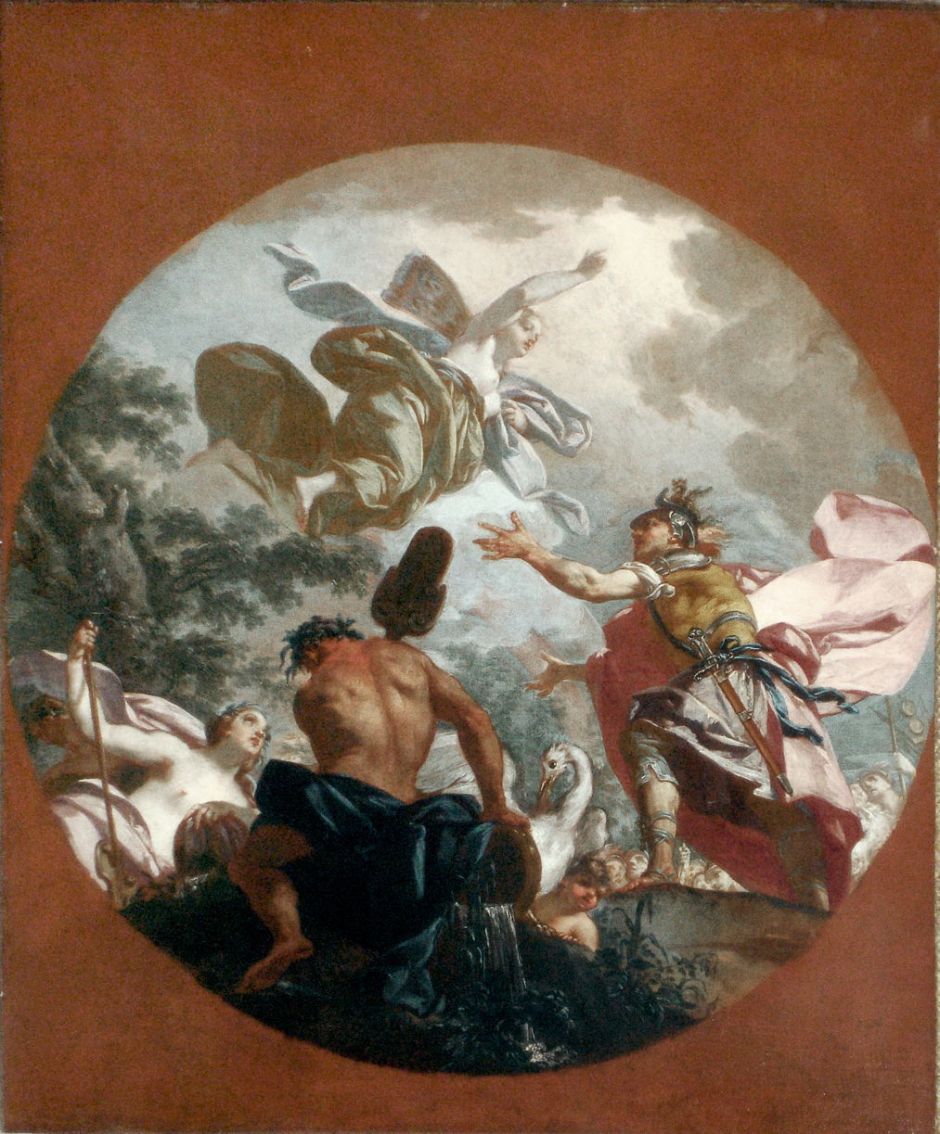In the first of these two articles, I showed paintings telling the story of Virgil’s Aeneid, as far as the hero’s departure from Dido in Carthage. As he sails away with his fleet towards his great destiny in Italy, she is distraught with grief and kills herself.

My favourite painting of Dido’s spectacular death is probably the only conventional history painting ever made by Henry Fuseli, known simply as Dido (1781). Dido has mounted her funeral pyre, and is on the couch on which she and Aeneas made love. She then falls on a sword which Aeneas had given her, and that rests, covered with her blood, beside her, its tip pointing up towards her right breast.
Her sister Anna rushes in to embrace her during her dying moments, and Jupiter sends Iris (shown above, wielding a golden sickle) to release Dido’s spirit from her body. Already smoke seems to be rising up from the pyre, which will confirm visually to Aeneas that she has killed herself, as he sails away.
The fleet has further trouble trying to pursue its course to the north, so they land on Sicily, where Aeneas holds funeral games to honour his father’s death. While these are taking place, Juno, through her divine messenger Iris, intervenes and tells the Trojan women to set fire to the fleet to stop their progress.

Claude Lorrain’s much earlier Trojan Women Set Fire to their Fleet (c 1643) shows the women preparing to do this. The building clouds warn of a storm sent by Jupiter in response to Aeneas’ prayers, which quenches the blaze, following which the women are transformed into mermaids at the behest of Cybele.
Aeneas then sees his father Anchises in a vision, in which he is told to go to the underworld for a vision of his future and that of Rome. The fleet finally reaches the coast of the Italian mainland, where Aeneas makes his way to Lake Avernus, a portal to the underworld.

JMW Turner’s first version of this scene is thought to have been his first mythological painting, back in his early career, in about 1798. This second version, Lake Avernus: Aeneas and the Cumaean Sybil, dates from 1814 or 1815, and is both an improvement on the original and in better condition.
True to the spirit of Claude’s landscape, this too is a mythological landscape showing the beautiful setting of Lake Avernus, near Pozzuoli, to the west of the city of Naples. In the distance is Baiae and the cliffs of Cape Miseno.
The Sibyl, who does not show her advanced years, holds aloft a golden sprig rather than the golden bough described by Virgil, and Aeneas stands with his back to the viewer, as if he too is enjoying the view. She guides Aeneas into the depths, across the River Acheron in Charon’s boat, and into Tartarus itself.

This magnificant painting, which has been attributed to Jan Brueghel the Elder, shows Aeneas and the Cumaean Sibyl in the Underworld (1600-25) in an image worthy of Hieronymus Bosch himself. After meeting Dido, the Sibyl guides him through the Elysian Fields, where Anchises tells him of the future of Rome before he returns to the surface.
This reaches the halfway mark of the Aeneid, with six further books to come, although they’re frequently glossed over, and proved unpopular with painters.
Aeneas and his survivors from Troy settle in Latium, where King Latinus has been advised by oracles that his daughter Lavinia will marry a foreigner, rather than the neighbouring King Turnus of the Rutuli.

Ferdinand Bol’s Aeneas at the Court of Latinus from about 1661-63 shows Aeneas awarding a laurel wreath to the victor of a maritime race.
Once again, Juno intervenes to try to block Aeneas from his destiny. She first uses the Fury Alecto to bring war between the Trojans and the Italian people.

Claudio Francesco Beaumont’s Iris Sent to Turnus by Juno from about 1738-40 is a sketch for one of the medallions in the vault of the Armeria Reale of Turin. It shows Iris sent by Juno to tell Turnus, the Rutulian warrior, that he must take advantage of the absence of Aeneas to attack the Trojans. This leads to the burning of their fleet, forcing Aeneas and his companions to settle in Italy.
Fighting between Turnus and his Rutuli and Aeneas with his Trojans culminates in a personal duel between them.

Luca Giordano’s Aeneas and Turnus from the late 1600s is one of the few paintings showing the battle between Aeneas and Turnus. The Trojan hero has Turnus on the ground, under his right foot. At the lower left is one of Aeneas’ ships. Venus, Aeneas’ mother, and Cupid, his half-brother, are at the upper left, and the goddess at the upper right is either Minerva (with her owl), or Juno – as losers in the Judgement of Paris, both bore a grudge against the Trojans.
Inevitably, this ends with Aeneas killing Turnus.
It took Ovid, in his Metamorphoses, to conclude the story of Aeneas. After he had founded the city of Lavinium, which was later instrumental in the founding of Rome, Aeneas was made an immortal god.

Charles Le Brun painted The Deification of Aeneas in about 1642-44. This is a faithful depiction from Ovid’s Metamorphoses, with the river god Numicus sat in the front, and Venus anointing Aeneas with ambrosia and nectar to make him immortal as the god Jupiter Indiges. At the right is Venus’ mischievous son Cupid, trying on Aeneas’s armour, and the chariot towed by white doves is ready to take the hero up to join the gods.

